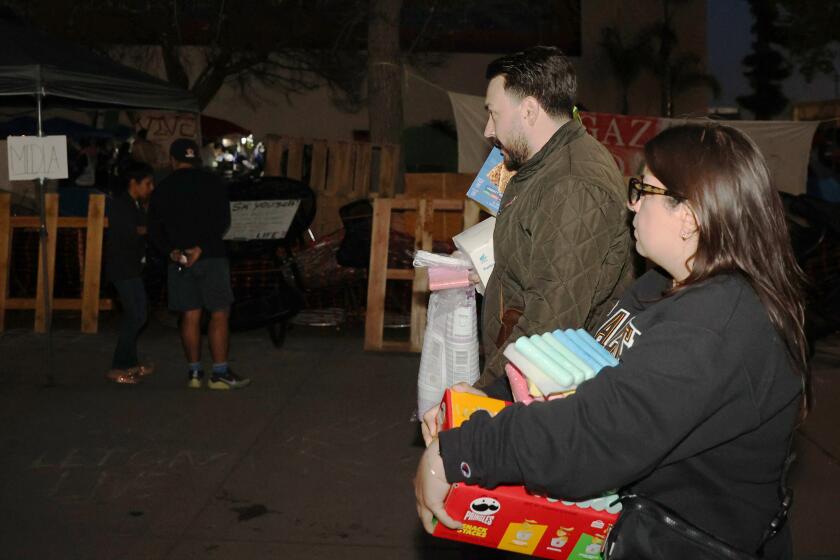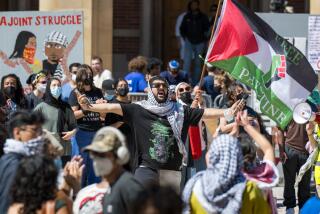‘I got a job, I got class’: Why Cal State L.A. isn’t roiling with protest
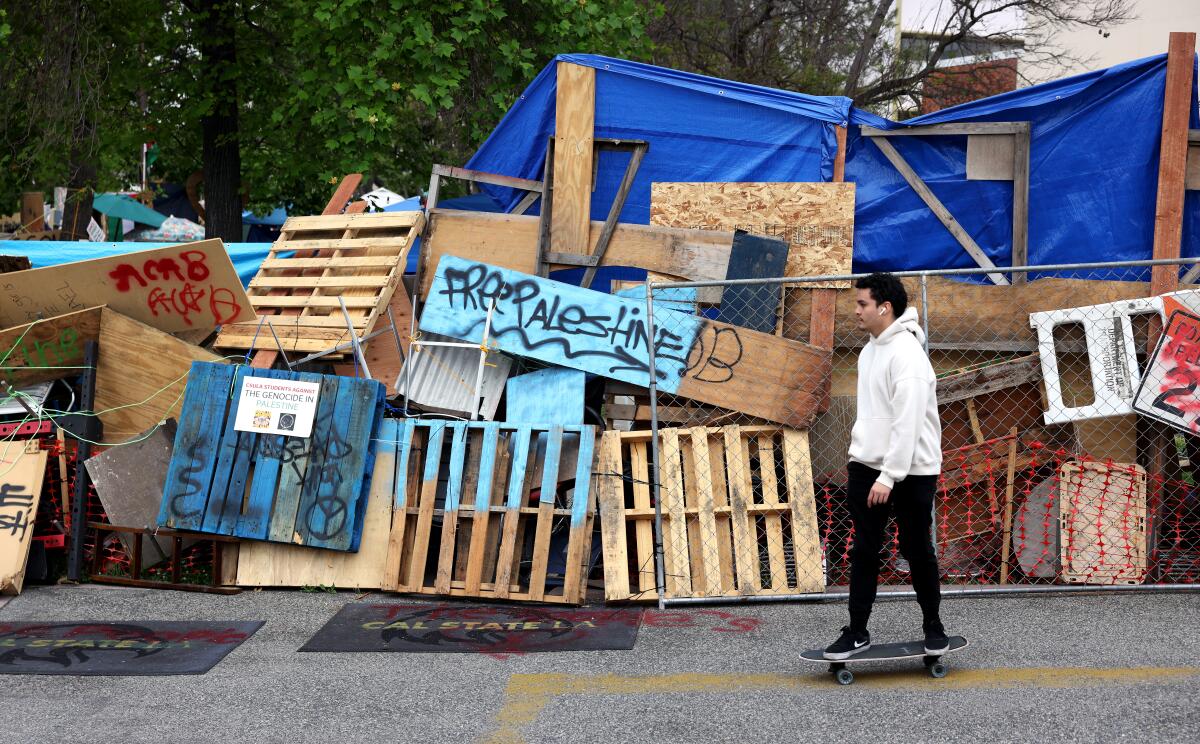
- Share via
On a recent Wednesday afternoon, the Cal State L.A. student union buzzed with people eating lunch. Outside, students took graduation photos wearing caps and gowns beside a yellow sign that read, “We are L.A.”
Not far away, a small group of student protesters continued their weeks-long encampment in solidarity with the people of Gaza.
On May 1, organizers established a Gaza Solidarity Encampment on a patch of grass beneath the “Olympic Fantasy” tile mural near the heart of campus. The encampment barrier, fortified with blue tarps and plywood, displays artwork decrying the bloodshed as Israel continues its military offensive in Gaza. Graffiti on a campus building behind the encampment trumpets “Free Gaza” in bold, colorful letters.
The campers’ demands on university leaders are much the same as those from protest organizers at USC, UCLA, Pomona College and other campuses across the country. They are asking the university to disclose its financial investments in companies that supply weapons to Israel and to divest from those funds. They want the Cal State L.A. president to issue a statement supporting a cease-fire in Gaza.
But there are also notable differences in the protest scenes as the encampment enters its fourth week.
The vibe here has been much quieter than the raucous events that unfolded at UCLA and USC, where police in riot gear moved in to clear encampments. Cal State L.A.’s president has said she would let the peaceful demonstration continue without law enforcement intervention. While some encampments have drawn many hundreds of students, the members of Cal State L.A.’s encampment could be counted in the dozens.
Part of that difference is sheer size: Cal State L.A. enrolls 23,000 students, about half the enrollment of UCLA and USC. And unlike those schools, Cal State L.A. is a commuter school. Only 1,000 to 2,000 students live on campus.
The demographics at Cal State are also markedly different from schools such as UCLA and USC. About 75% of Cal State’s student body is Latino, and many of the students are working-class and older than traditional college populations. Just more than 2% of students come from other countries.
By contrast, Asians and whites make up more than 60% of the undergraduate student body at UCLA, where 9% of undergraduates and 17% of graduate students hail from other nations. At USC, a private school, 27% of students are international.
But perhaps the greatest distinction involves free time: Most students at Cal State L.A. are juggling schoolwork with jobs and pressing responsibilities at home.
Shawna Andrews, a nursing student at Cal State L.A., said she hadn’t heard much about the Israel-Hamas war until she saw the encampment. The 29-year-old appreciates the message the protesters are sending. But Andrews, who is graduating, said she simply hasn’t had the bandwidth to pay close attention to the Gaza war between being a full-time student and caring for a family member in the early stages of dementia.
“There are other things that just grab my focus that are here, that are next to me, surrounding me, versus something that’s going on overseas,” Andrews said.
Brian Hernandez, an information systems major, echoed those sentiments. “You do need a little bit of privilege to actually protest … that type of way. To sit in a random place and just hang out,” the 25-year-old said. “I can’t spend days sleeping on a campus. … I got a job, I got class.”
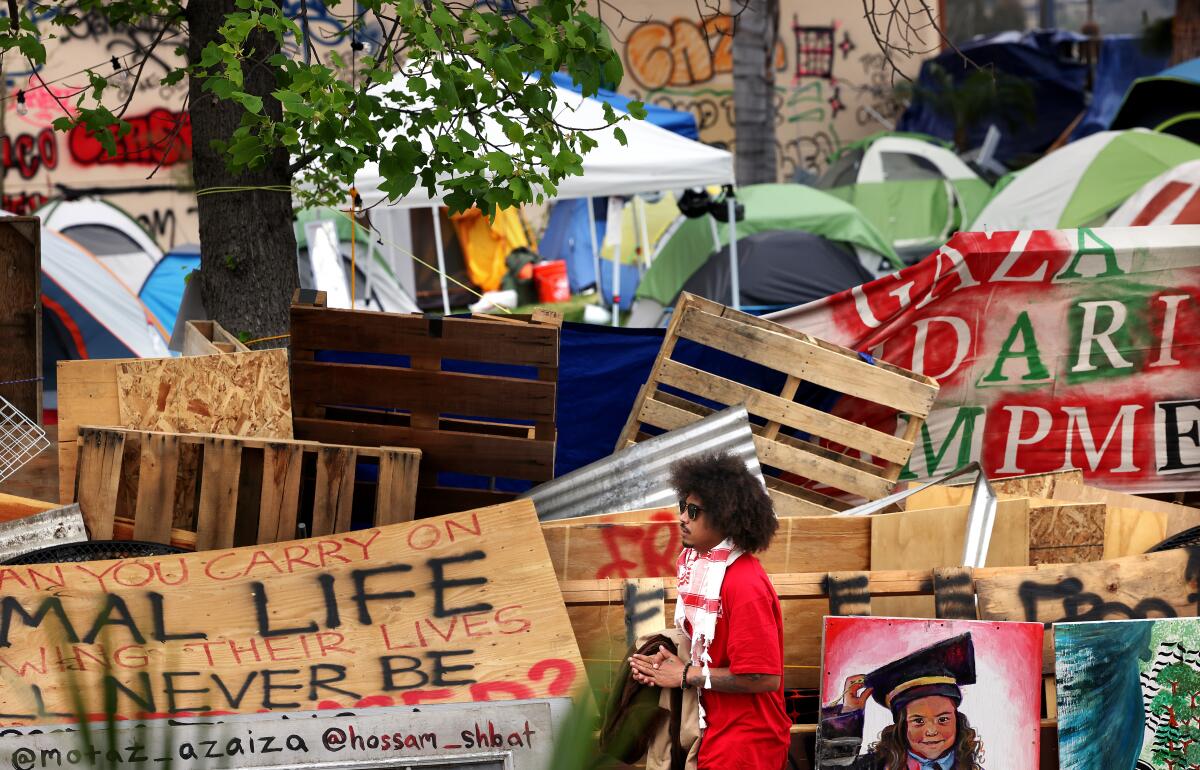
Though their numbers may be smaller than at some other Los Angeles-area schools, the students who raised the Cal State L.A. encampment are ardent about their cause. They vowed this week to stay until their demands were met, even as the semester wound down and commencement ceremonies took place.
“In terms of demographics, the people who are in there, they may not be related to the Palestinians in that way, but we deeply, deeply care because it’s the most devastating thing ever,” said one organizer, who provided only her first name, Sarah, for fear of being harassed online. “We’re students and we’re community, and we still care. Those are the values that our families have instilled in us.”
The Cal State L.A. encampment is at a commuter school on the Eastside, with a blue-collar, Latino-majority student body of all ages who wouldn’t seem to have the time to protest, let alone live in a tent town for days.
Last week, Cal State L.A. President Berenecea Johnson Eanes and other administrative leaders met inside the encampment with the protesters to discuss their demands. Eanes reaffirmed her commitment to allowing the students to continue their encampment as a form of free speech. She agreed to disclose Cal State L.A.’s foundation and auxiliary investments, which campus leaders have control over, and to recommend revisions to its investment policies “by adding a human rights-based approach” and reviewing current investments to align with that policy.
Eanes did not agree to issue a statement supporting a cease-fire in Gaza.
“I want to emphasize and I understand, again, that this has been a traumatic experience for many people and many people are suffering pain. It is not lost on me at all,” Eanes said. “I hope that you see my conversation with you as my ongoing commitment to staying in collaboration and staying in communication.”
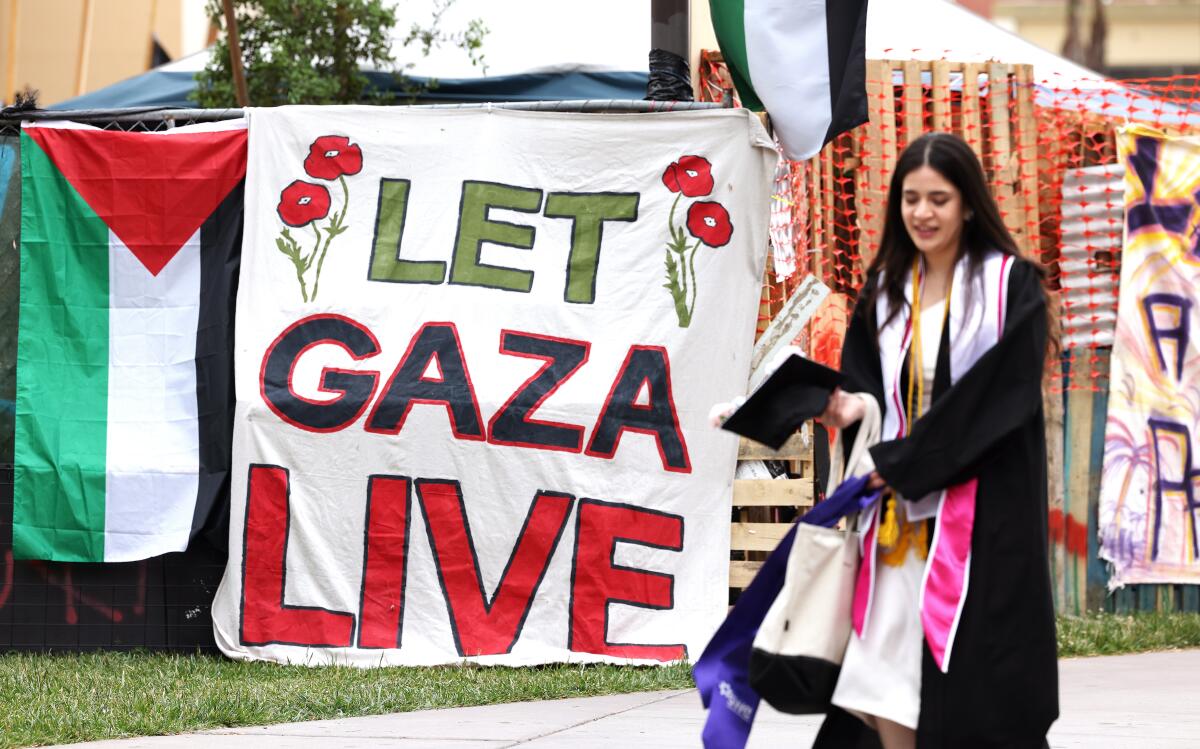
Leda Ramos, a professor of Chicana(o) and Latina(o) Studies, was also at the encampment last week, helping students monitor who entered. They welcomed passersby to stop in and ask questions, which some did. Ramos’ two daughters are also participating in the encampment, she said.
“This is a demographic that — it’s amazing — that commutes for the most part and really struggles with economic security, and … [there is a] huge number of first-generation students,” Ramos said. “So we’re aware of how this is such a sacrifice.”
One student organizer said she was maintaining a work and class schedule while also staying at the encampment.
“We’re not only working-class students going to work, having jobs, but we also know what’s going on the world and we’ve taken it upon ourselves to be here,” said Red, who like many of the protesters declined to give her full name for fear of harassment. “It’s not that we’re unaware. I think the system has made it so that we don’t focus on those things.”
The community, Ramos noted, has been supportive with donations of food and other items. As Ramos spoke, a woman stopped by to hand one of the organizers a $20 bill. Moments later, a student appeared with a donation of two large jugs of water and offered two thumbs up.
Another student, wearing cap and gown, took a break from graduation photos to chat with the protesters. “Thank you for standing up,” the student told them. The photographer, also a student, shared her gratitude as well.
“I’m Lebanese; this has been my reality for my entire life,” the student said. She promised to stop by later.
More to Read
Sign up for Essential California
The most important California stories and recommendations in your inbox every morning.
You may occasionally receive promotional content from the Los Angeles Times.
